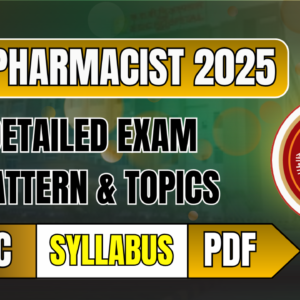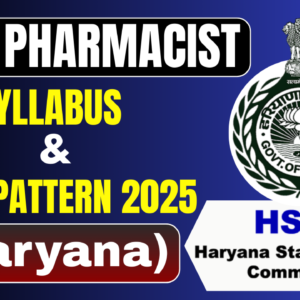GSSSB Pharmacist Recruitment 2025 Syllabus
Detailed Exam Pattern & Complete Syllabus Guide
The Gujarat Subordinate Service Selection Board (GSSSB) has announced a significant recruitment drive for 128 Junior Pharmacist positions for the year 2025. This provides a valuable opportunity for aspiring pharmacy graduates. To succeed, candidates must familiarize themselves with the comprehensive syllabus and exam pattern. This post provides a detailed breakdown to guide your preparation.
GSSSB Junior Pharmacist: Selection Process & Exam Pattern
The selection for the Junior Pharmacist role will be conducted through a single-stage competitive written examination. The test will be in an objective (MCQ) format and can be either a Computer-Based Response Test (CBRT) or an OMR-based test. The question paper will be bilingual, available in both Gujarati and English.
Key points to note:
- Total Marks: 200
- Total Duration: 3 Hours
- Negative Marking: There will be a deduction of 0.25 marks for every incorrect answer.
- Qualifying Criteria: Candidates must secure a minimum of 40% marks in each of the two parts separately to qualify.
| GSSSB Pharmacist Examination Pattern 2025 | |||
|---|---|---|---|
| Part | Subject | Marks | Duration |
| Part A | Reasoning and Quantitative Aptitude | 40 | 3 Hours (Total) |
| Gujarati Language and Grammar | |||
| English Language and Grammar | |||
| Part B | General Knowledge | 160 | |
| Technical (Pharmacy) Subjects | |||
| Total | 200 Marks | ||
GSSSB Pharmacist: Detailed Syllabus 2025
Part A: General Aptitude (40 Marks)
This section evaluates a candidate’s mental ability, language skills, and numerical proficiency.
1. Reasoning and Quantitative Aptitude
- Logical Reasoning: Analogy, classification, series, coding-decoding, blood relations, direction sense, etc.
- Quantitative Aptitude: Number systems, simplification, HCF & LCM, percentage, average, ratio and proportion, profit and loss, time and work, time and distance, simple and compound interest.
2. Gujarati Language and Grammar
- Vocabulary, synonyms, antonyms, grammar (parts of speech, sentence structure), comprehension, and translation of sentences.
3. English Language and Grammar
- Vocabulary, synonyms, antonyms, grammar (tenses, articles, prepositions, verbs), sentence structure, comprehension, and error correction.
Part B: General Knowledge & Technical Subjects (160 Marks)
This section carries the highest weightage, focusing on core pharmacy knowledge and general awareness with special emphasis on Gujarat.
1. General Knowledge
- History and Culture of India and Gujarat: Major historical events, cultural heritage, and significant movements.
- Geography of India and Gujarat: Physical features, climate, rivers, and natural resources.
- Indian Polity and the Constitution of India: Key features of the constitution, fundamental rights and duties, and the structure of government.
- Panchayati Raj: Structure and functioning of the Panchayati Raj system in Gujarat.
- Welfare Schemes: Welfare schemes of the Gujarat State and Union Government.
- Indian Economy and Planning: Basic economic concepts, five-year plans, and current economic trends.
- General Science, Environment, and IT: Basic principles of science, environmental issues, and recent developments in Information Technology.
- Current Affairs: Regional, national, and international current events of significance.
- Sports: Important sporting events, awards, and personalities.
2. Technical (Pharmacy) Subjects
The syllabus is based on the curriculum of a Diploma or Degree in Pharmacy.
Pharmaceutics
- Introduction to different dosage forms
- Metrology and calculations
- Packaging of pharmaceuticals
- Size separation and size reduction
- Mixing and homogenization
- Clarification and filtration
- Heat processes & Distillation
- Introduction to sterilization and aseptic techniques
- Processing of tablets, capsules, and liquid orals
Pharmaceutical Chemistry
- Acids, bases, and buffers
- Antioxidants
- Gastrointestinal agents & Topical agents
- Dental products
- Major intra and extracellular electrolytes
- Radiopharmaceuticals and contrast media
- Quality control of drugs and pharmaceuticals
Pharmacognosy
- Definition, history, and scope of Pharmacognosy
- Classification of drugs
- Quality control of crude drugs
- Study of different categories of drugs of natural origin
Human Anatomy and Physiology
- Scope of Anatomy and Physiology
- Structure of a cell & Tissues of the human body
- Osseous system (bones)
- Cardiovascular, Respiratory, Digestive, and Nervous systems
Biochemistry and Clinical Pathology
- Introduction to biochemistry
- Carbohydrates, lipids, and proteins
- Vitamins and enzymes
- Introduction to pathology of blood and urine
Pharmacology and Toxicology
- Introduction to Pharmacology & Routes of administration of drugs
- General mechanism of drug action
- Pharmacokinetics and Pharmacodynamics
- Drugs acting on the CNS, autonomic nervous system, and cardiovascular system
- Chemotherapy and antibiotics
Hospital and Clinical Pharmacy
- Hospital Pharmacy: Organization and management
- The drug distribution system in hospitals
- Manufacturing in hospitals
- Clinical Pharmacy: Introduction and scope
- Modern dispensing aspects
Jurisprudence (Pharmaceutical Laws)
- Origin and nature of pharmaceutical legislation in India
- Pharmacy Act, 1948
- Drugs and Cosmetics Act, 1940 and Rules, 1945
- Narcotic Drugs and Psychotropic Substances Act, 1985
- Drugs and Magic Remedies (Objectionable Advertisement) Act, 1954
Drug Store and Business Management
- Introduction to drug store management
- Types of business organizations
- Inventory control
- Sales promotion
- Recruitment and training of pharmacists
| Important Links & Resources | |
|---|---|
| Download Official Syllabus PDF | Click Here |
For further details, candidates are advised to refer to the official notification on the GSSSB website once it is released.
MORE :AIIMS CRE Pharmacist Syllabus 2025 | Detailed Exam Pattern
<<<<<<<<<<<<JOIN US>>>>>>>>>>>>>>>>
| Subscribe our PHARMACY INDIA YouTube Channel for more Pharma Updates | Click Here |
| Follow us on Instagram | Click Here |
| Download PHARMACY INDIA MOBILE APP from Google Play Store | Click Here |
| Follow us on LinkedIn | Click Here |







One thought on “GSSSB Pharmacist Syllabus 2025 – Download PDF & Exam Details”